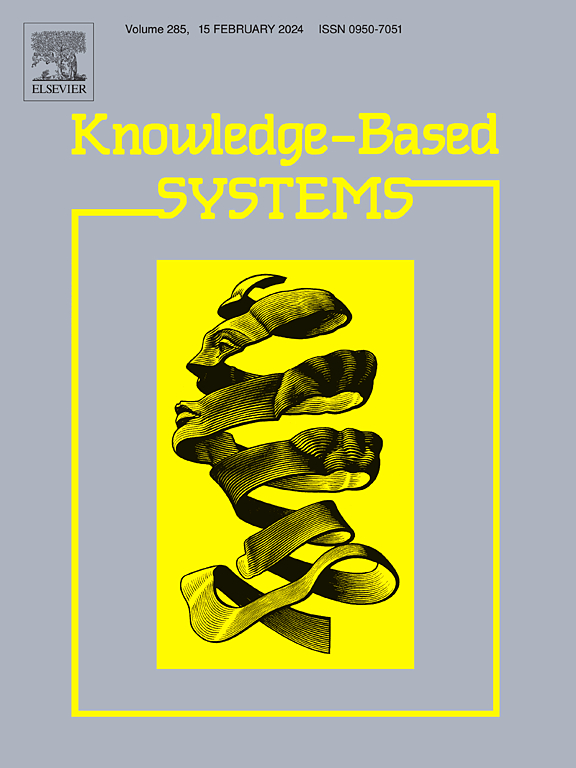基于实例引导的帧视频信息融合网络用于甲状腺超声视频实例分割
IF 7.6
1区 计算机科学
Q1 COMPUTER SCIENCE, ARTIFICIAL INTELLIGENCE
引用次数: 0
摘要
视频实例分割(VIS)在甲状腺超声图像中具有自动分割结节和分配实例标签的优点,有助于结节计数和甲状腺关键平面的确定。然而,甲状腺US视频的特点是背景噪声丰富,回声相似。再加上视频流中组织结构形状的持续变化,当前主流的VIS方法很难识别时间动态变化特征,限制了其在分割和跟踪方面的性能。为了解决这一问题,本文提出了一种关键实例导向的帧视频信息融合网络(NoVIS),用于甲状腺视频实例分割。首先,引入帧级实例信息增强模块捕获关键实例信息,构建鲁棒的关键实例特征,增强同一实例内的相似度;其次,提出了一个关键实例导向的全局信息聚合模块。该模块利用关键实例特征不断更新全局时间信息,旨在捕捉视频流中结构的动态变化特征。最后,匹配机制保证了训练和推理的一致性,进一步提高了跟踪的稳定性。在收集的甲状腺视频数据集上进行了大量的实验,结果表明NoVIS在跟踪和分割方面都明显优于其他方法。其中,NoVIS的AP为58.09%,AP50为81.33%,分别比基线法提高了3.37%和5.09%。此外,所提出的方法具有确定甲状腺关键平面和计数结节的能力,对甲状腺全自动临床诊断具有重要价值。本文章由计算机程序翻译,如有差异,请以英文原文为准。
A key instance-guided frame-to-video information fusion network for thyroid ultrasound video instance segmentation
Video instance segmentation (VIS) in thyroid ultrasound (US) images has the advantages of automatically segmenting nodules and assigning instance labels, which aids in counting nodules and determining the thyroid key plane. However, thyroid US videos are characterized by abundant background noise and echo similarity. Coupled with the continuous variations in the shape of tissue structures along the video stream, it becomes extremely challenging for current mainstream VIS methods to identify the temporal dynamic change features, limiting their performance in segmentation and tracking. To address this issue, this paper proposes a key instance-guided frame-to-video information fusion network (NoVIS) for thyroid US video instance segmentation. First, a frame-level instance information enhancement module is introduced to capture key instance information, constructing robust key instance features and enhancing similarity within the same instance. Second, a key instance-guided global information aggregation module is proposed. This module leverages key instance features to continuously update the global temporal information, aiming to capture the dynamic variation characteristics of structures along the video stream. Finally, a matching mechanism ensures consistency between training and inference, further improving tracking stability. Extensive experiments were conducted on a collected thyroid US video dataset, which demonstrated that NoVIS significantly outperforms other methods in both tracking and segmentation. Specifically, NoVIS achieves an AP of 58.09% and an AP50 of 81.33%, which are 3.37% and 5.09% higher than those of the baseline method, respectively. Furthermore, the ability of the proposed method to determine the thyroid key plane and count nodules is demonstrated, which is highly valuable for fully automated thyroid clinical diagnosis.
求助全文
通过发布文献求助,成功后即可免费获取论文全文。
去求助
来源期刊

Knowledge-Based Systems
工程技术-计算机:人工智能
CiteScore
14.80
自引率
12.50%
发文量
1245
审稿时长
7.8 months
期刊介绍:
Knowledge-Based Systems, an international and interdisciplinary journal in artificial intelligence, publishes original, innovative, and creative research results in the field. It focuses on knowledge-based and other artificial intelligence techniques-based systems. The journal aims to support human prediction and decision-making through data science and computation techniques, provide a balanced coverage of theory and practical study, and encourage the development and implementation of knowledge-based intelligence models, methods, systems, and software tools. Applications in business, government, education, engineering, and healthcare are emphasized.
 求助内容:
求助内容: 应助结果提醒方式:
应助结果提醒方式:


